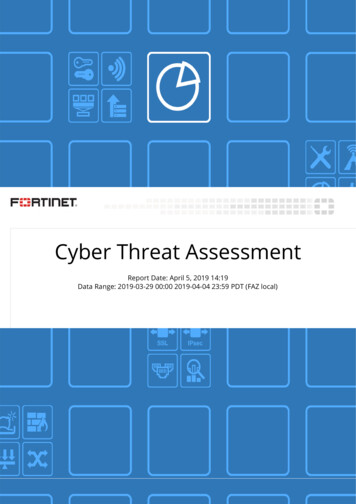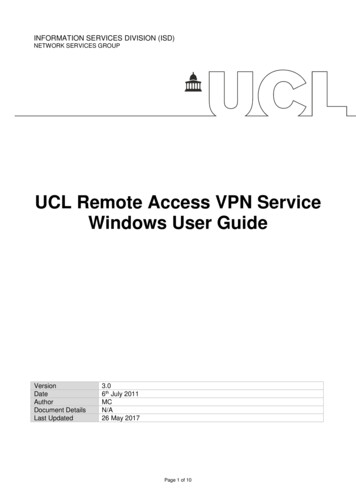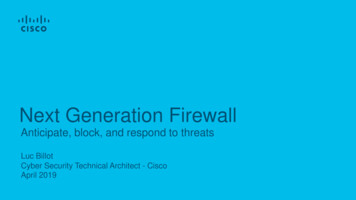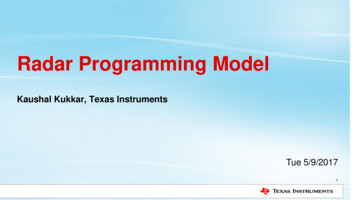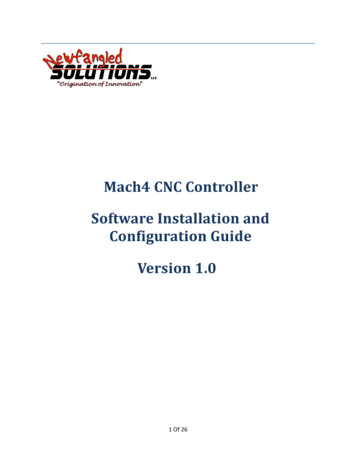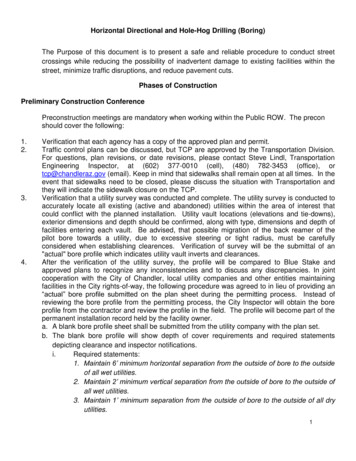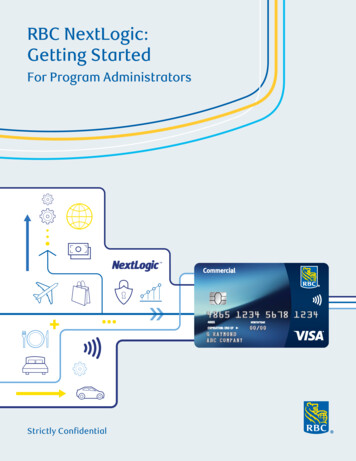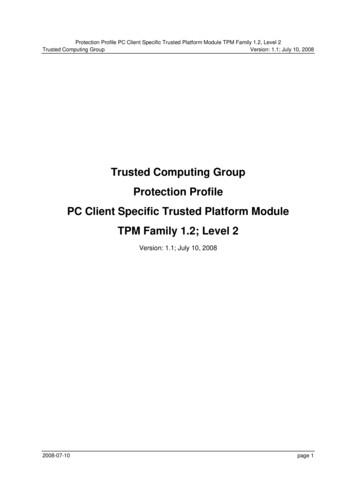
Transcription
Protection Profile PC Client Specific Trusted Platform Module TPM Family 1.2, Level 2Trusted Computing GroupVersion: 1.1; July 10, 2008Trusted Computing GroupProtection ProfilePC Client Specific Trusted Platform ModuleTPM Family 1.2; Level 2Version: 1.1; July 10, 20082008-07-10page 1
Protection Profile PC Client Specific Trusted Platform Module TPM Family 1.2, Level 2Trusted Computing GroupVersion: 1.1; July 10, 2008This page is intentionally left blank.2008-07-10page 2
Protection Profile PC Client Specific Trusted Platform Module TPM Family 1.2, Level 2Trusted Computing GroupVersion: 1.1; July 10, 2008Table of content1.PP Introduction. 51.1.PP Reference . 51.2.PP organization . 51.3.TOE Overview . 51.3.1.TOE Definition. 51.3.2.Security services. 61.3.3.TPM life cycle. 81.3.4.User, Subjects, Objects and Operations. 102.Conformance Claims. 222.1.CC Conformance Claim. 222.2.PP Claim. 222.3.Package Claim . 223.Extended Components Definition. 233.1.Family Random Number Generation. 234.Security Problem Definition . 244.1.Threats . 244.2.Organisational Security Policies . 254.3.Assumptions . 265.Security Objectives . 275.1.Security Objectives for the TOE . 275.2.Security Objectives for the Operational Environment . 295.3.Security Objectives Rationale. 306.Security Requirements . 406.1.Security Functional Requirements for the TOE . 406.1.1.General SFR . 406.1.2.Cryptographic support. 422008-07-10page 3
Protection Profile PC Client Specific Trusted Platform Module TPM Family 1.2, Level 2Trusted Computing GroupVersion: 1.1; July 10, 20086.1.3.TPM Operational Modes . 466.1.4.Identification, Authentication and Binding . 526.1.5.Data Protection and Privacy . 606.1.6.Data Import and Export. 826.1.7.DAA. 916.1.8.TSF Protection . 936.2.Security Assurance Requirements for the TOE. 966.3.Security Requirements Rationale . 976.3.1.Rationale for the Security Functional Requirements. 996.3.2.Rationale for the Security Assurance Requirements . 1096.3.3.SFR Dependency Rationale . 1107.Annex. 1187.1.Ordinal table . 1187.2.Acronyms. 1237.3.Glossary . 1247.4.Literature . 1288.Optional Package “Revoke of Trust” (Informative Annex) . 1302008-07-10page 4
Protection Profile PC Client Specific Trusted Platform Module TPM Family 1.2, Level 2Trusted Computing GroupVersion: 1.1; July 10, 20081. PP Introduction1.1.PP ReferenceTitle: Protection profile PC Client Specific Trusted Platform Module Family 1.2; Level 2 (PPTPM F1.2L2)Version: 1.1; July 10, 2008Author: Trusted Computing GroupPublication date: TBD1.2.PP organizationThis protection profile (PP) describes security requirements for the Trusted Computing Group(TCG) PC Client Specific Trusted Platform Module (TPM) Family 1.2; Level 2 conforming tothe Common Criteria version 3.1 release 2. The TOE of the current PP is a PC ClientSpecific TPM conforming to the TPM specification version 1.2, level 2 [5] [6] [7], where theTOE of the TPM PP [10] is a TPM conforming to the TPM specification version 1.1b. Theupdate of the TPM specification introduces new security features, deprecated and deletedcommands which affect the current TPM PP in the security problem definition, the securityobjectives and the security requirements.The informal annex of this PP provides an optional package for the revocation of trust asoptional security feature of the TPM.The current TPM PP is conforming to Common Criteria version 3.1 whereas the TPM PP [10]conforms to the Common Criteria version 2.1. This results in editorial changes of thecommon security requirements which are common to both PP.1.3.TOE Overview1.3.1.TOE DefinitionThe TOE is the TCG PC Client Specific Trusted Platform Module (PCCS TPM). This TPM ishardware, firmware and/or software that implements the functions defined in the TCGTrusted Platform Module Main Specification, version 1.2, [5] [6] [7] and the PC client specificinterface specification [8]. The TCG Trusted Platform Module Specification describes thedesign principles [5], the TPM structures [6] and the TPM commands [7]. The PC ClientInterface Specification [8] describes the platform-specific set of requirements of the TPM forthe PC Client, the details of what interfaces and protocols are used to communicate with theTPM and specific items like the minimum number of PCRs required and NV Storageavailable.The primitives provided by the TOE include cryptographic algorithms for key generation,digital signatures, random number generation, sealing data to system state, protectedstorage, binding information to the TPM, support of direct anonymous attestation andphysical protection. Attestation by the TOE is an operation that provides proof of data known2008-07-10page 5
Protection Profile PC Client Specific Trusted Platform Module TPM Family 1.2, Level 2Trusted Computing GroupVersion: 1.1; July 10, 2008to the TPM. This is done by digitally signing specific internal TPM data using an AttestationIdentity Key (AIK). The acceptance and validity of both the integrity measurements and theAIK itself are determined by the Verifier. The AIK is obtained using either the PrivacyCertification Authority or the Direct Anonymous Attestation (DAA) protocol. The DAA is aprotocol for vouching for an AIK using zero-knowledge-proof technology.1.3.2.Security servicesThe PCCS TPM provides all services required for a TPM in the TCG Trusted PlatformModule Main Specification, version 1.2, [5] [6] [7] and additional services that are optional inthe main TPM specification but mandatory in the PC client specific interface specification [8].The PCCS TPM provides physical protection for internal user data and TSF data.In TCG systems roots of trust are components that must be trusted because misbehaviormight not be detected. There are commonly three Roots of Trust in a trusted platform; a rootof trust for measurement (RTM), root of trust for storage (RTS) and root of trust for reporting(RTR). The RTM is a computing engine capable of making inherently reliable integritymeasurements. Typically the normal platform computing engine is controlled by the core rootof trust for measurement (CRTM). The CRTM is the instructions executed by the platformwhen it acts as the RTM. The RTM is also the root of the chain of transitive trust. The RTS isa computing engine capable of maintaining an accurate summary of values of integritydigests and the sequence of digests. The RTR is a computing engine capable of reliablyreporting information held by the RTS. The TCG Specification Architecture Overview [11]provides a more detailed description.Support for the Root of Trust for MeasurementThe TPM supports the integrity measurement of the trusted platform by calculation andreporting of measurement digests of measured values. The measurement values arerepresentations of embedded data or program code scanned and provided to the TPM by themeasurement agent, such as the Root-of-Trust-for-Measurement. The TPM supportscryptographic hashing of measured values and calculates the measurement digest byextending the value of a Platform Configuration Register (PCR) with a calculated or providedhash value by means of the SHA-1. The PCRs are shielded locations of the TPM which canbe reset by TPM reset or a trusted process, written only through measurement digestextensions and read.Root of Trust for ReportingThe root of trust for reporting (RTR) exposes the measurement digests stored in the PCRsand attests to the authenticity of these measurement digests based on trusted platformidentities or the Direct Anonymous Attestation Protocol. The trusted platform identities forRTR are defined by Attestation Identity Credentials for Attestation Identity Keys (AIK) 1generated by the TPM. The TPM creates digital signatures over the PCR values using anAttestation Identity Key.1Cf. glossary section 7.3 for details2008-07-10page 6
Protection Profile PC Client Specific Trusted Platform Module TPM Family 1.2, Level 2Trusted Computing GroupVersion: 1.1; July 10, 2008Each TPM is identified and validated using its Endorsement Key. A TPM has only oneendorsement key pair. The Endorsement Key is transitively bound to the Platform via theTPM as follows:-An Endorsement Key is bound to one and only one TPM (i.e., there is a one to onecorrespondence between an Endorsement Key and a TPM.)-A TPM is bound to one and only one Platform, (i.e., there is a one to onecorrespondence between a TPM and a Platform.)-Therefore, an Endorsement Key is bound to a Platform, (i.e., there is a one to onecorrespondence between an Endorsement Key and a Platform.The Endorsement Key is used in the process of issuance the Attestation Identity Credentialsand to establish a platform owner.Root of Trust for StorageThe TPM may be used to provide secure storage for an unlimited number of private keys orother data by means of encryption. The resulting encrypted file, which contains headerinformation in addition to the data or key, is called a BLOB (Binary Large Object) and isoutput by the TPM and can be loaded in the TPM when needed. The functionality of the TPMcan also be used so that private keys generated on the TPM can be stored outside the TPM(encrypted) in a way that allows the TPM to use them later without ever exposing such keysin the clear outside the TPM. The TPM uses RSA key technology to encrypt data and keysand may implement cryptographic algorithms of equivalent strength.The functionality used to provide secure storage is:-TPM Seal and TPM Unseal, which perform RSA encrypt and decrypt, respectively, ondata that is externally generated. The sealing operation encrypts not only the data, butalso the values of the selected PCRs and the locality that must exist during for unsealand tpmProof, which is a unique secret identifier for the TPM sealing the data. To unsealthe data, three conditions must exist: 1) the appropriate key must be available forunseal, 2) the TPM PCRs must contain the values defined at the time of the sealoperation, and 3) the value of tpmProof must be the same as that encrypted during theseal operation. By requiring the PCR values to be duplicated at unseal and the tpmProofvalue to be checked, the seal operation allows software to explicitly state the future“trusted” configuration that the platform must be in for the decrypted key to be used andfor decryption to only occur on the specified TPM.-TPM Unbind, which RSA decrypts a blob created outside the TPM that has beenencrypted using a public key where the associated private key is stored in the TPM.The key types used for the Root for Trust of Storage include:-The Storage Root Key (SRK), which is the root key of a hierarchy of keys associatedwith a TPM; it is generated within a TPM and is a non-migratable key. Each owned TPMcontains a SRK, generated by the TPM at the request of the Owner. Under that SRKmay be organized different trees dealing with migratable data or non-migratable data.2008-07-10page 7
Protection Profile PC Client Specific Trusted Platform Module TPM Family 1.2, Level 2Trusted Computing GroupVersion: 1.1; July 10, 2008-Storage keys, which are used to RSA encrypt and RSA decrypt other keys and sealeddata with their security attributes in the Protected Storage hierarchy, only.-Binding Keys, which are used for TPM Unbind operations only. A binding operation(performed outside the TPM) associates identification and authentication data with aparticular data set and the entire data blob is encrypted outside the TPM using a bindingkey, which is an RSA key. The TPM Unbind operation uses a private key stored in theTPM to decrypt the blob so that the data (often a key pair) stored in the blob may beused.Other security services and featuresThe TPM provides cryptographic services hashing of arbitrary data by means of the hashfunction SHA-1 and creation of digital signatures with signing keys which must be a leaf ofthe Storage Root Key hierarchy. The private key of a singing key pair is used for signingoperations only.The TPM provides non-volatile storage as a shielded location for data of external entities.The TPM owner controls access to the non-volatile storage. The access control may includethe need for authentication of the user, delegations, PCR values and other controls.Keys managed by the TPM may be non-migratable, migratable or certifiable migratable. Anon-migratable key is a key that cannot be transported outside beyond a specific TPM. Amigratable key is a key that may be transported outside the specific TPM. In addition somekeys must be bound to a specific TPM but should be able to be backed-up or migrated undercertain circumstances. The certified migration allows a Migration Selection Authoritytherefore to control a migration process without handling the migrated key itself orrespectively uses a Migration Authority to control the migration process without theknowledge of the data or the migrated key. Those keys which are intended for certifiedmigration are called certifiable migratable keysThe TPM provides a “tick counter” as a count of the number of ticks that have occurred sincethe start of a timing session. The time between the ticks is identified via a “tick rate” but it isthe responsibility of the caller to associate the ticks to an actual UTC time.The TPM provides also a monotonic counter as an ever-increasing incremental value forexternal use.1.3.3.TPM life cycleThe TPM life cycle has 7 phases from the protection profile prospective:1. TPM development2. TPM manufacturing3. Platform manufacturing and delivery4. Platform deployment phase2008-07-10page 8
Protection Profile PC Client Specific Trusted Platform Module TPM Family 1.2, Level 2Trusted Computing GroupVersion: 1.1; July 10, 20085. Platform identity registration6. Platform operation7. Platform recycling and retirementThe Figure 1 shows typical activities of the TPM life cycle Phase 1 to Phase 7. The Phase 1and 2 are TOE development and manufacturing. They are subject of the evaluation of thedevelopment environment. The functions in the white area are implemented (e.g. or at leastsupported) by the TOE (e.g. EK may be generated by the TOE or injected into TOE). Thegrey area shows activities in the TOE environment.Development TPMdevelopmentPlatformDeliveryManufacturing TPMmanufacturing OEM EK keypair generation TPMconformancetesting TPM-Mfg EKkey pairgeneration ordownloadPlatformDeployment DAA Sign Key Migration TPM/Platformownership AIK key pairgeneration Key Backup/Recovery Post-Mfg. EKkey generation Activation of theIdentity User credentialsissuance Platformownershipcleared Key erasures RevokeTrust Maintenance OEM-Issued EKcredentialissuance Organizationspecificprovisioning Platform TBBmanufacturingand assembly Platformconformancetesting (e.g.VARs) Integrity Valuescreation andcollection ormOperation DAA Join TPM-Mfg EKcredentialissuance Platform TBBconformancetestingPlatformIdentityRegistration IntegrityAssertionscreationcreation Post-Mfg EKcredentialissuance IntegrityAssertionscreation Platformauthentication(for various Credentials policy platforms)creation and Assetpublicationmanagement AIK credentialissuance Garbagecollection (e.g.Credentialsrevocations). Credentialsexpiration Trusted networkconnections Data archival/erasure Platform HealthServices Credentialsarchiving (legal) ConfigurationPolicy creationTOE development environmentTOE deliveryTOE preparationTOE operationalFigure 1: TOE lifecycleThe whole life-cycle of the TPM will be considered during evaluations based on thisProtection Profile as far as the developer/manufacturer of the TOE is directly involved.The scope of the assurance components referring to the product’s life-cycle is limited toPhases 1 and 2. These phases are under the control of the TPM developer and the TPMmanufacturer. This includes the interfaces to the other phases where information andmaterial is being exchanged with the partners of the developer/manufacturer of the TOE. TheTPM manufacturer may use the TOE security functions like endorsement key generationdescribed by security functional requirements.2008-07-10page 9
Protection Profile PC Client Specific Trusted Platform Module TPM Family 1.2, Level 2Trusted Computing GroupVersion: 1.1; July 10, 2008The security functional requirements addressed in this protection profile are mainly used inthe Phase 3 to Phase 7.Application note 1: The intention of the PP is to consider phases 1 and 2 as part of theevaluation and therefore define TOE delivery according to CC as after phase 2 or later. Theinitialization process and its environment may depend on specific security needs of aplatform developer or costumer. The security target shall describe the instantiation of the lifecycle defined in this PP that is relevant for the product evaluation process. It is important todefine the point of TOE delivery in the life cycle required for the evaluation according to CCrequirements ALC DEL. All development and manufacturing steps before TOE delivery haveto be part of the evaluation under assurance class ALC. This includes generating and loadingthe endorsement key into the TPM if this manufacturing option is used for the TOE. Allproduction, generation and installation procedures between TOE delivery and operationalusage have to be considered in the product evaluation process under AGD PRE assurancefamily. Therefore, the Security Target has to outline the partition the TPM developmentenvironment and the TOE operational environment and the related security objectives for theTOE development into aspects that are relevant before and after TOE delivery.1.3.4.User, Subjects, Objects and OperationsUser rolesA user is any active entity outside of the TOE. Six operational roles of users are defined forthe TOE.(1) TPM ownerThe TPM owner controls the use of the Endorsement Key and of the Storage Root Key.The TPM owner creates and controls the Attestation Identity Keys. The TPM Ownerdoes the selection and the authorization of migration authorities at any time prior to keymigration. The TPM owner may partly delegate his authorization to other users.(2) Delegated entityThe TPM owner or another delegated entity (within their authorization) may delegate itsauthorization for selected commands to a delegated entity by means of a delegationtable in a delegation blob. The delegation table lists the command ordinals allowable foruse by the delegate, the identity of a process that can use the ordinal list, and theAuthData value to use the ordinal list (cf. to [5] chapter 29 for details).(3) Entity ownerThe user creating an entity and defining the entity owner token AuthData as securityattribute of this entity by means of the AuthData Insertion Protocol (ADIP). Thepresentation of the entity owner token is required for loading this entity into the TPM.2008-07-10page 10
Protection Profile PC Client Specific Trusted Platform Module TPM Family 1.2, Level 2Trusted Computing GroupVersion: 1.1; July 10, 2008(4) Entity userEntity user uses a loaded entity. The authentication of more than one entity user, i.e.,verification of knowledge of the entity user token (i.e. usageAuth), may be required as acondition of using a loaded entity.(5) User using operatorAuthUser under physical presence may define authorization data operatorAuth for a user roleallowed to deactivate temporarily the TPM.(6) WorldThe role “World” is assigned to any user not authenticated for any role listed above.The TPM knows some user roles by permanently stored individual authentication data: theTPM owner using ownerAuth and a user role defined by operatorAuth2. Other user roles areobject specific (entity owner and entity user). The users may use these roles except “World”after authentication only. The user establishing an OSAP session negotiates theauthorization handle and the shared secret as user authentication data during this session.The user have the following security attributes which are indicated to the TPM in a platformspecific way-Physical presenceThe TCG policies require physical presence to be indicated to the TPM to enable theuser to execute privileged commands3 or to alter the following states if no TPM owner isdefined: disabled, deactivated, and (ownership-)disabled (cf. [5], chapter 10, and section6.1.3 TPM Operational Modes pf this PP for further details). The TPM and platformmanufacturer define the way how the TPM physical presence is asserted by hardwareinput. The physical presence may be asserted by means of the commandTSC PhysicalPresence (cf. [7], section 6.6).-LocalityWhen a platform is designed with a trusted process, the trusted process may wish tocommunicate with the TPM and indicate that the command is coming from the trustedprocess. The commands that the trusted process sends to the TPM are the normal TPMcommands with a Locality modifier that indicates that the trusted process initiated thecommand. The TPM accepts the command as coming from the trusted process merelydue to the fact that the modifier is set (cf. [5], chapter 16, for further details).23This user is some times referred to as “operator”.cf. the ordinal table 12, column “Physical presence”2008-07-10page 11
Protection Profile PC Client Specific Trusted Platform Module TPM Family 1.2, Level 2Trusted Computing GroupVersion: 1.1; July 10, 2008SubjectsIn the context of this PP the subjects are:-the initialization process initiated by the TPM Init signal of the platform to the TPM,-the self test which is started after initializationTPM ContinueSelfTest command is received,-a process receiving, executing and responding to a single command,-a session (sequence of commands) which may establish shared secrets, encryptionkeys, and session logs.andcontinuedaftertheThe session may be an authorization session (cf. [5], ch. 13), monotonic counter sessions(cf. [5], sec. 20.1), a tick session (cf. [5], sec. 20.1) or a transport session (cf. [5], chapter 18).In order to communicate with a subject, users shall first associate themselves with thatsubject, through a process called binding. Binding is established with-the user “World” by default,-other users by means of authorization protocols as described in the TPM Main Part 1Design Principles [5], chapter 13.The subject is associated with the security attributes-the authData, locality and physical presence presented by the user,-the rolling nonce, authorization handles if the subject is a session,-the authorization handle and the shared secret if the subject is a OSAP session,-the authorization associated with the delegation blob if the subject is a DSAP session,-the current PCR values.The Object Specific Authorization Protocol (OSAP) session is bound to an object. TheObject-Independent Authorization Protocol (OIAP) session is independent on any object.Objects and OperationsThe data in the shielded location and the protected capabilities of the TPM are the TOEassets. The objects treated by the TOE are the data generated or stored in the shieldedlocation or to be imported into or to be exported from the shielded location. The operations ofthe TOE are the protected capabilities of the TPM. They are defined by the TPM commands(cf. [7]).2008-07-10page 12
Protection Profile PC Client Specific Trusted Platform Module TPM Family 1.2, Level 2Trusted Computing GroupVersion: 1.1; July 10, 2008The TPM holds operational mode flags as security attributes for all objects stored in theTPM PERMANENT FLAGS (cf. [6] sec. 7.1) and TPM STCLEAR FLAGS (cf. [6] sec. 7.2)4: disable: flag whether the TPM is enabled (FALSE) / disabled (TRUE), deactivated: flag whether the TPM is active (FALSE) / inactive (TRUE), owner: flag indicating whether an owner is installed, unowned (TRUE) / owned(FALSE)5.The default value of “disable”, “deactivated” and “unowned” is TRUE.The security attributes associated with data objects are stored as TPM permanent data, flagsin the TPM and other TPM resources (e.g. NV storage) or associated with data in anencrypted blob. Note that the authorization data associated with an object define theauthorized user and the related authentication reference data for this user.The table 1 list the objects, the operation via reference to the commands as described in theTPM specification [7] and the security attributes of the objects as described in the TPMspecification [6].Table 1: Objects, operations, security attributes and authorization data#1ObjectEK6TheTPM4567Operationgenerate: generate an permanent EK (cf. cmd TPM Createnon-revocable EndorsementKeyPair [7], sec.Endorsement 14.1)7.Security attributes andauthorization dataownerAuth: authorizationdata to read public key partand to use EK, defined inTPM PERMANENT DATAThis PP uses the names of the security attributes e.g. “disabled” and refers to the structure wherethey are stored (i.e. TPM PERMANENT FLAGS for the security attribute “disabled”). Thestructures are described in the TPM specification part 2 [6]. The security attributes are used in thecommands described in the TPM specification part 3 [7].The TPM specification does not define a specific flag indication whether a TPM owner is installedor not in [6] sec. 7.1. The TPM TakeOwnership inserts the TPM Ownership value into the TPM.The TPM OwnerClear and TPM ForceClear clears (“unowns”) the TPM owner value. TheTPM TakeOwnership decides on existence of a valid ownerAuth whether the TPM is owned ornot. The readPubek flag is set to FALSE by TPM TakeOwnership and set to TRUE byTPM OwnerClear and TPM ForceClear, thus mirroring if a TPM Owner is present (cf. [7], sec.14.4).This PP addresses permanent (non-revocable) EK only. Revocation of trust and a revocable EKare optional features described in the package Revoke of Trust, cf. informative annex of this PP.Note the TPM specification [5] and [7] allows for the manufacturing option to generate the EKoutside the TPM or to “squirt” the EK into the TOE. Because the PP defines mandatory SFR only itwas decided that the PP does not include security functional requirements for generation or“squirting” the EK. The ST shall state whether generation or “squirting” of the EK (cf. [5], ch. 5) is2008-07-10page 13
Protection Profile PC Client Specific Trusted Platform Module TPM Family 1.2, Level 2Trusted Computing GroupVersion: 1.1; July 10, 2008#ObjectKey (EK) is an asymmetric RSA key pairwhichisuniquelyass
TOE of the TPM PP [10] is a TPM conforming to the TPM specification version 1.1b. The update of the TPM specification introduces new security features, deprecated and deleted commands which affect the current TPM PP in the security problem definition, the security objectives and the security requirements.
